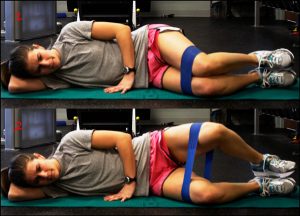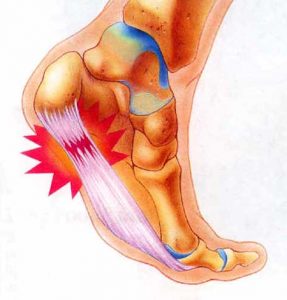How to Treat Running Injuries – The 3 Most Common Running Injuries

How to Treat Running Injuries
We all run for different reasons, whether it’s to push personal limits against the clock, reduce stress and maintain sanity, or just to eat like you’re still a teenager. One thing is for sure, running is a lifestyle that’s hard to give up! This is especially true when it is due to an injury. Here are the 3 most common running injuries, advice for home care, and a “how to” guide to treat running injuries.
The following three running injuries are seen most commonly by the sports chiropractors at Elite Sport & Spine. Base purely on statistics you will likely experience one of these at some point, if you haven’t already. But don’t fear, we have compiled the best options to help expedite the recovery process.
Iliotibial Band Syndrome (ITBS)
Iliotibial band syndrome is a common running injury, occurring in up to 12 percent of all runners (1). Because of the frequency with which it occurs, it is important to understand why it happens, what you can do to prevent it, and how to get rid of it should you have symptoms. The pain associated with this syndrome is often described as “burning” and can be experienced at the lateral aspect of the knee, along the outside of the thigh, or both.

Clam shell exercise to strengthen the hips, prevent, and treat running injuries
One of the best ways to tackle Iliotibial Band Syndrome is through myofascial release. This can be performed at home with a foam roller or by a sports chiropractor with Active Release Technique or Graston Technique. Foam roller therapy is an essential aide for several running injuries, including ITBS. If you’re new to foam rolling, it can be a bit overwhelming as foam rollers come in all shapes, sizes, and densities.
There are multiple resources online to assist in choosing the right one for you, or you can seek the help of our sports chiropractors or a running expert at a local running store, like Performance Running Outfitters.
There are several preventative measures that you can take to avoid ITBS, including foam rolling, stretching, and strengthening exercises. Hip strengthening exercises can also assist to correct and treat running injuries. We generally recommend clam shells and glute bridges as a good place to start.
For more information on treatment and prevention of ITBS from our running specialist and sports chiropractor click here.
Shin Splints
 About 10-20 percent of all runners experience a bout of medial tibial stress syndrome (MTSS), or shin splints, at some point during their career (3). The cause of shin splints, sometimes used as a “catch-all” term for anterior lower leg pain, most often can be summed up by this phrase: too much, too soon. Whether it’s a beginning runner adding mileage too quickly or a veteran runner rapidly increasing intensity, the large change in a short period of time does not allow the soft tissues enough time to adapt to the new stresses and demands.
About 10-20 percent of all runners experience a bout of medial tibial stress syndrome (MTSS), or shin splints, at some point during their career (3). The cause of shin splints, sometimes used as a “catch-all” term for anterior lower leg pain, most often can be summed up by this phrase: too much, too soon. Whether it’s a beginning runner adding mileage too quickly or a veteran runner rapidly increasing intensity, the large change in a short period of time does not allow the soft tissues enough time to adapt to the new stresses and demands.
Shin splints often feel worse in the morning or at the beginning of exercise because the soft tissue tightens at rest. Shin splints are also at their most painful when you dorsiflex your foot and ankle or bring your toes toward your shin.
The standard self-treatment protocol is R.I.C.E (rest, ice, compression, and elevation) or M.I.C.E (movement – pain free range of motion such as light stretching, ice, compression, and elevation). Kinesiotaping can also be beneficial, just make sure you follow the appropriate instructions which can be found here. Be sure to ease into new running routines and give yourself enough recovery between hard workouts.
For more information on treatment and prevention of shin splints or MTSS from our running specialist and sports chiropractor click here.
Plantar Fasciitis
 Plantar Fasciitis can be an extremely painful condition, caused by inflammation and swelling of the plantar fascia (the thick band of connective tissue on the bottom of the foot). It is the most common cause of heel pain in runners, affecting approximately 10 percent of the running community (7). It is often considered an overuse injury, but is more accurately caused by poor mechanics in the gait cycle (walking or running), excessive body weight, or improper footwear. Tight or stiff Achilles tendons, calf muscles, hamstrings, or weak foot muscles also increase risk factors (8, 9).
Plantar Fasciitis can be an extremely painful condition, caused by inflammation and swelling of the plantar fascia (the thick band of connective tissue on the bottom of the foot). It is the most common cause of heel pain in runners, affecting approximately 10 percent of the running community (7). It is often considered an overuse injury, but is more accurately caused by poor mechanics in the gait cycle (walking or running), excessive body weight, or improper footwear. Tight or stiff Achilles tendons, calf muscles, hamstrings, or weak foot muscles also increase risk factors (8, 9).
There are multiple things to help avoid this painful condition or treat it quickly at the first signs of symptoms. Wearing the appropriate shoes for your foot type is very important in preventing plantar fasciitis! We work closely with Performance Running Outfitters to ensure that our patients are being fit for the proper shoes, whether it’s a neutral, stability or motion control shoe. Just as you should stretch and foam roll the muscles in your legs frequently, the same holds true for the muscles and connective tissue in your feet. Whether you choose a tennis ball, golf ball, or water bottle, stretching and rolling the soft tissues in the bottom of your feet will keep those tissues functioning properly and pain-free (10).
The primary cause of pain in plantar fasciitis is repeated micro-tearing of the fascia followed by scar tissue formations and adhesions. Self-treatments alone or combined with rest may only minimally reduce the pain and do little to prevent recurrence. If plantar fasciitis persists, it is recommended to seek the assistance of a sports chiropractor.
For more information on treatment and prevention of planter fasciitis from our running specialist and sports chiropractor click here.
How We Treat Running Injuries
Perhaps you will be one of the fortunate ones who is able to avoid these injuries or the need to treat running injuries of any kind. But if not, you now have some basic knowledge to guide you on the path to recovery. Hopefully with consistent stretching, foam rolling, and proper recovery, you will be back out on the roads or trails in no time. If you are not one of the lucky few, here is the approach our sports chiropractors take to treat running injuries in the clinic setting.

Graston Technique, an instrument assisted soft tissue mobilization technique, performed on the plantar fascia
Graston Technique or Active Release Technique
If your condition isn’t responding to your attempts at self-treatment, find someone certified in soft tissue mobilization. The primary goals of a sports chiropractor using Graston Technique or Active Release Technique to treat running injuries are threefold. First, aid in the disruption and breakdown of the adhesions. Second, increase normal tissue flexibility, movement and comfort. Finally, aim to restore full flexibility, balance, and stability.
To treat running injuries like ITBS, shin splints, or plantar fasciitis, Graston and Active Release Techniques are often performed on the injured or painful muscle as well as the muscles above and below the painful site. The treatment is complemented with specific stretches and strengthening exercises (9, 11). Most patients report a positive response within 4-6 treatments.
* Disclaimer: Always consult with your healthcare professional (preferably a sports chiropractor!) before starting any type of exercise or stretching program, especially if you have any health concerns. Stretches, exercises, or products highlighted in this article are intended to provide relief but do not guarantee full resolution or cure.
References
- Fredericson M, Wolf C. Iliotibial band syndrome in runners: innovations in treatment. Sports Med, 2005;35:451-459.
- Fairclough J, Hayashi K, et al. The functional anatomy of the iliotibial band during flexion and extension of the knee: implications for understanding iliotibial band syndrome. J Anat, 2006;208:309-316.
- Reshef N, Guelich DR. Medial tibial stress syndrome. Clin Sports Med. 2012 Apr;31(2):273-90.
- Hamstra-Wright KL, Bliven KC, Bay C. Risk factors for medial tibial stress syndrome in physically active individuals such as runners and military personnel: a systematic review and meta-analysis. Br J Sports Med. 2015 Mar;49(6):362-369.
- Plisky MS, Rauh MJ, et al. Medial tibial stress syndrome in high school cross-country runners: incidence and risk factors. J Orthop Sports Phys Ther. 2007 Feb;37(2):40-7.
- Griebert MC, Needle AR, et al. Lower-leg Kinesio tape reduces rate of loading in participants with medial tibial stress syndrome. Phys Ther Sport. 2014 Jan 29.
- DeMaio M, Paine R, et al. Plantar fasciitis. Orthopedics 1993; 16:1153-1163.
- Michaud, Thomas. Foot Orthoses and Other Forms of Conservative Foot Care. Newton, MA: 1997. Print.
- Michaud, TC. New techniques for treating plantar fasciitis. Published Jun. 6, 2014, Competitor.com
- DiGiovanni B, Nawoczenski D, et al. Tissue-specific plantar fascia-stretching exercise enhances outcomes in patients with chronic heel pain. A prospective, randomized study. J Bone Joint Surg. 2003;85-A:1270–1277.
- Renan-Ordine R, Alburquerque-Sendin F, et al. Effectiveness of myofascial trigger point manual therapy combined with a self-stretching protocol for the management of plantar heel pain: a randomized controlled trial. J Orthop Sports Phys Ther. 2011;41:43.
 262-373-9168
262-373-9168




